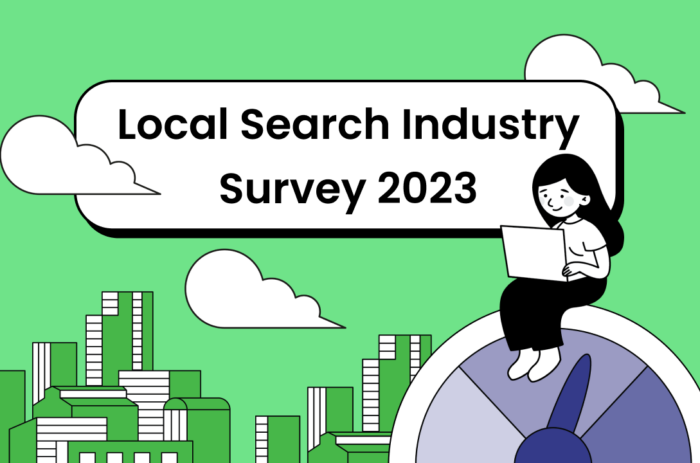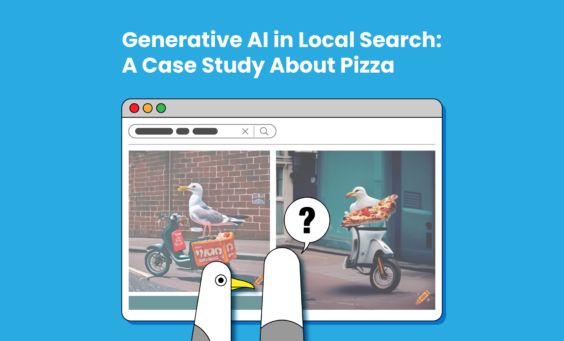- 93% of local marketers have experimented with generative AI tools.
- The average salary for US local marketers is $109,575, up 15% from $91,152 in 2022.
- 46% of marketers feel ‘somewhat satisfied’ with their salaries.
- 92% of local marketers rate their local SEO knowledge as 'Good' or better.
- 48% of marketers with 'Excellent' local SEO knowledge are 'Very' or 'Extremely' happy with their salaries.
- 61% of single and multi-location businesses have an annual revenue of $1mil or above.
- 52% of freelancers see an annual revenue of less than $50,000.
- 28% of agencies earn an annual revenue of $1mil or above.
- 46% of marketers believe achieving local SEO will be harder in the next year compared to 36% in 2022.
- Despite 54% of marketers not having access to a training budget, 98% of marketers are dedicating time to learning within their roles.
- The top three most common local SEO services offered are GBP management, content creation, and on-site optimization.
Now in its twelfth year, the Local Search Industry Survey is the only report dedicated to specifically benchmarking the local SEO industry on an annual basis.
With eleven years of insights behind us, we’ve reported throughout some of the biggest and most unprecedented events to shake the industry, and the wider economic environment as a whole.
The information provided by local marketers enables us to compile the current picture of the industry, from salary averages and overall satisfaction at work to a run-down of how agencies and freelancers are offering and billing for their services.
So, let’s dive straight into this year’s findings.
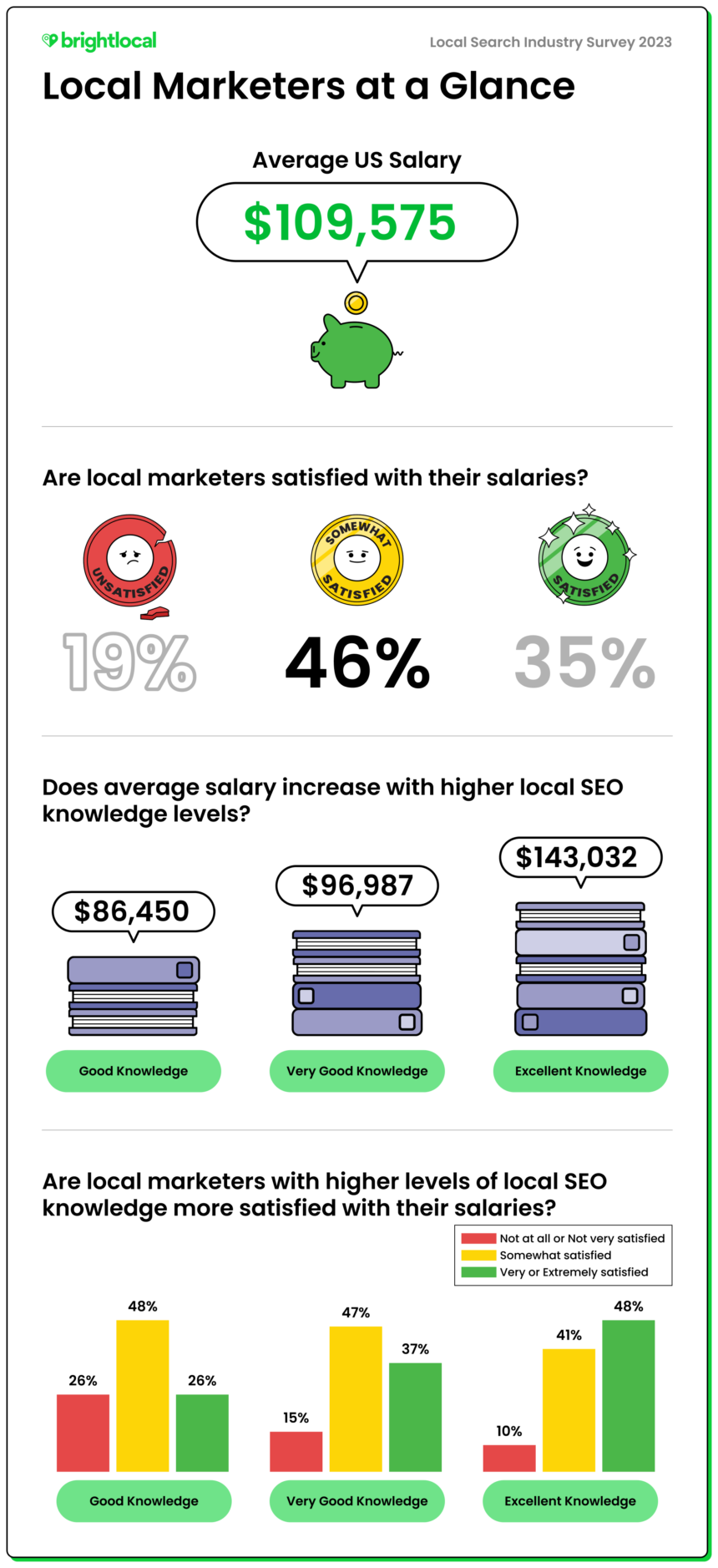
Local Marketers at a Glance
Firstly, who do we mean when we talk about ‘local marketers’? We surveyed 534 representatives with roles in marketing or SEO functions involving a local focus. This included freelance consultants and representatives from agencies, small businesses, and multi-location businesses.
While you can find the summary of this year’s survey participants within the research methodology in full (at the bottom of this page), it’s important to note that 72% of this year’s respondents identified as local marketers based in the US. The remaining 28% represent the UK (6%), Canada (5%), Australia (3%), and 24 other countries (14%).
For that reason, salary averages have been converted into US dollars at the current rate, so that we can provide an accurate representation.
Salary averages
We compared the average and median salaries of local marketers in the US to data from our 2022 and 2021 surveys.
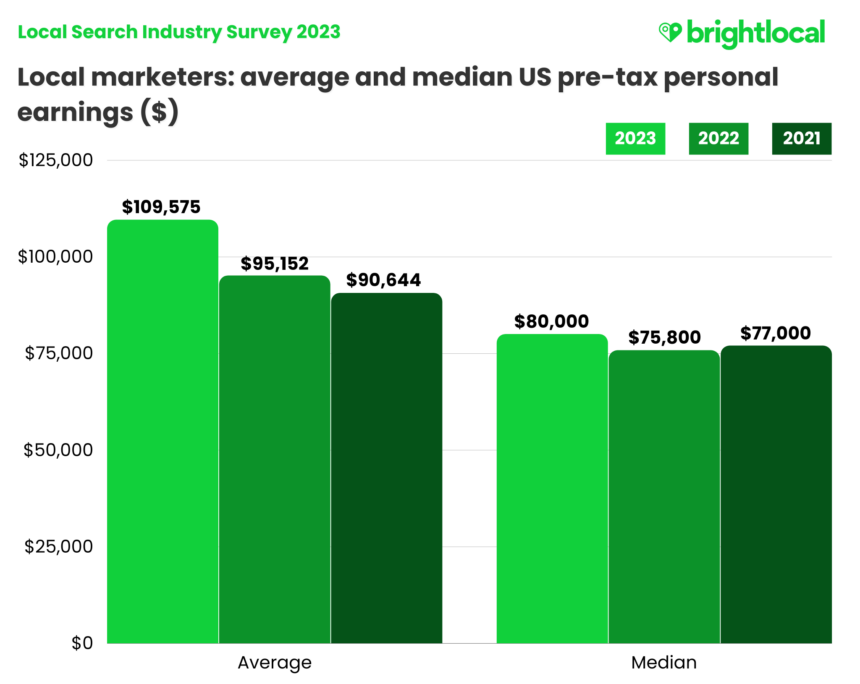
As well as a clear upward trend in the average US pre-tax earnings since 2021, we can also see that the increase in 2023 is significantly larger than that seen in 2022. Between 2022 and 2023, the average local marketing salary has increased by 15%, compared to an increase of 5% between 2021 and 2022.
Interestingly, while the median salary range has also increased since 2021, the percentage increase is 6%. Comparing the increase in average salary to the increase in median salary, it tells us that there are outliers weighted much more towards the high-earning end of the scale.
Correspondingly, as we’ll delve further into in a few sections’ time, 71% of survey respondents self-described as being in ‘Senior’ positions within their organizations.
How satisfied are marketers with their salaries?
It’s one thing to measure average earnings within the industry, but how satisfied do marketers feel with their salaries in general?

- The majority of local marketers feel ‘somewhat satisfied’ with their salaries (46%).
- The percentage of local marketers feeling generally unsatisfied with their earnings has increased from 14% in 2022 to 19% in 2023.
Broadly, it appears that most local marketers feel okay about what they’re taking home, and this has not changed from 2022—with 46% of marketers responding as ‘somewhat satisfied’.
However, there also appears to be a trend showing that more local marketers are unsatisfied with their salaries in 2023 compared to 2022. 19% reported feeling unsatisfied in 2023, compared to 14% in 2022, while the percentage of satisfied respondents has decreased from 39% in 2022 to 35% in 2023.
So, while it seems that local marketers are earning more on average in 2023 than in 2022, they’re also feeling less fulfilled by it. There could be several reasons causing this, with the biggest and most obvious external factor being the rising cost of living across so many parts of the globe.
And, although salaries tend to increase annually in line with inflation, it could also be the case that some marketers are not feeling enough of a difference against rising costs elsewhere.
Do job seniority and knowledge levels affect earnings?
We wanted to take a closer look at factors specific to the local SEO industry and how they might affect salary satisfaction. First, we examined the relationship between job seniority and salary satisfaction.
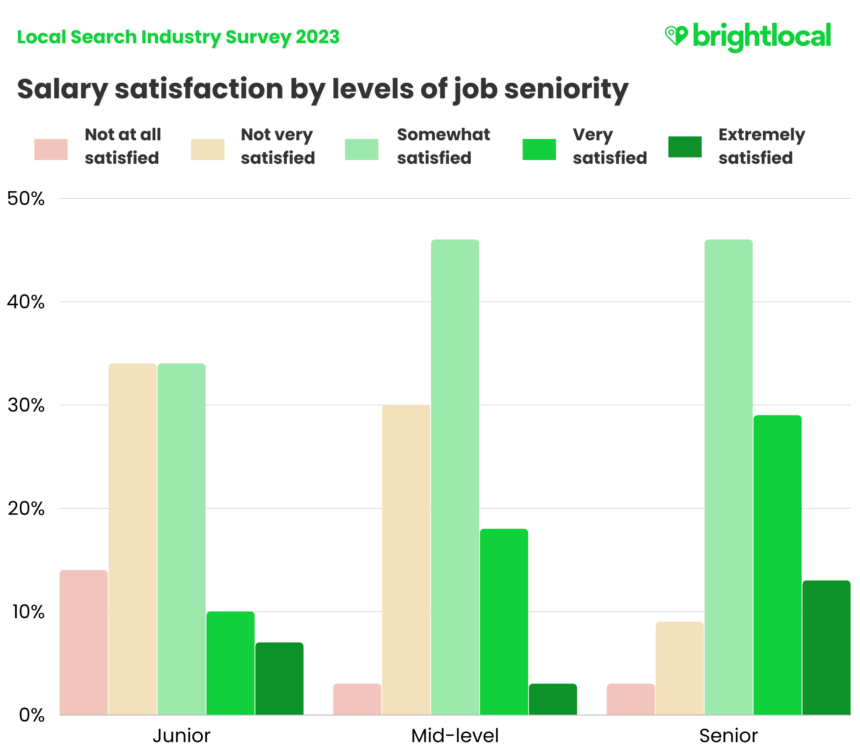
- 42% of senior local marketers are ‘Very’ or ‘Extremely’ satisfied with their salaries, compared to 21% of mid-level marketers and 17% of junior marketers.
- Junior local marketers are the most unsatisfied with their salaries, with 48% reporting being either ‘Not very’ or ‘Not at all’ satisfied with their earnings.
The chart presents a clear picture: senior local marketers are much more likely to be satisfied with their salaries than those working at mid- or junior levels. It makes sense, considering it is generally the case that more senior roles have higher salary bands attached to them.
However, as noted previously, 71% of survey respondents identified as senior-level marketers, including a significant amount of business owners, CEOs, and directors, so you would expect to see these within the high-earning bracket.
So, we analyzed the relationship between salary satisfaction and expertise, first asking: how do local marketers rate their levels of local SEO knowledge?
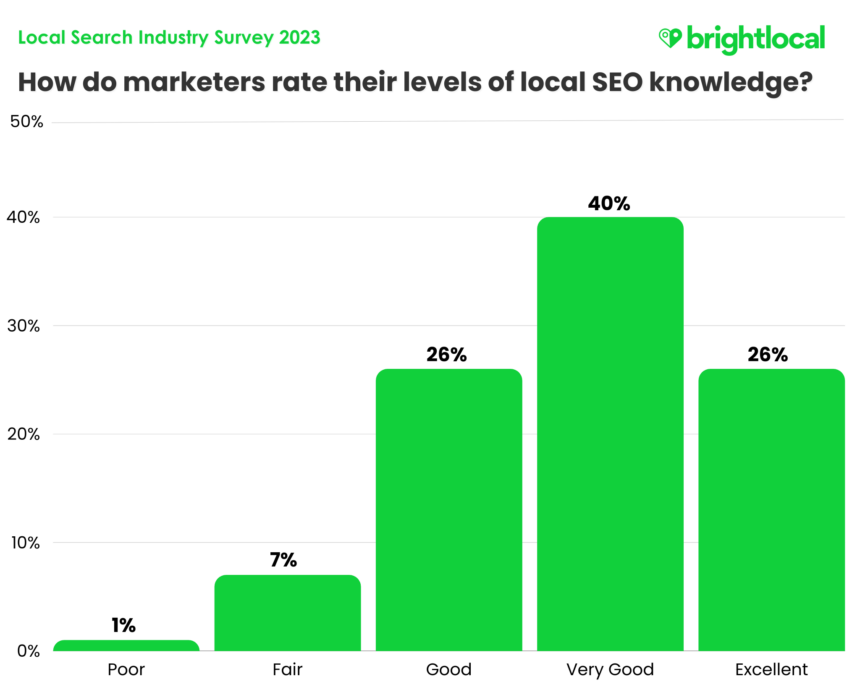
- 92% of local marketers rate their local SEO knowledge as ‘Good’ or better.
- Just 1% of local marketers believe they hold poor levels of local SEO knowledge.
We can see here that being more senior doesn’t necessarily equate to being an expert—in this case, holding ‘Excellent’ levels of local SEO knowledge. Just over a quarter of respondents rated their expertise as ‘Excellent’.
Generally, though, local marketers rate their knowledge levels as good, with only 8% highlighting ‘Fair’ or ‘Poor’ knowledge levels.
So, with this in mind, would we find a relationship between expertise and better salaries? We took the pre-tax earnings of our US respondents to calculate the average earnings against the level of local SEO knowledge.
| Good Knowledge | Very Good Knowledge | Excellent Knowledge |
|---|---|---|
| $86,450 | $96,987 | $143,032 |
The results speak for themselves, but we were still surprised by the jump between salary averages from ‘Very Good’ to ‘Excellent’ knowledge levels. It goes to show: the more you know!
Now, returning to all local marketers and not just the majority earning in USD, we compared salary satisfaction against self-proclaimed knowledge levels.
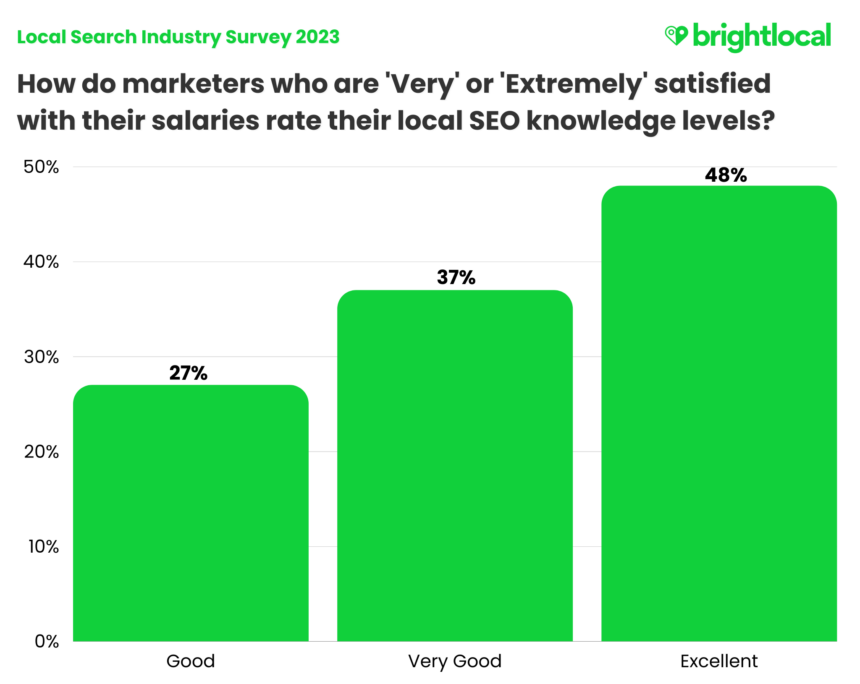
To quote a certain US sitcom legend, could it be any clearer? Not only are individuals who possess ‘Excellent’ levels of local SEO knowledge earning the most on average, but they’re also the most satisfied with their salary.
The biggest takeaway here for local marketers should be that you don’t necessarily need to reach director levels to become an expert in your work. Honing your expertise within your field and building on your local SEO knowledge will help you to become a subject matter expert and, as it happens, you can put a price on that!
Working in Local SEO
We’ve compiled a snapshot of the individuals working in local marketing, but what’s it like to work on it, day-to-day?
Annual revenue for agencies and freelancers in the local marketing industry
Looking at freelancer revenue alongside marketing agency revenue can be a useful measure for freelancers when considering billing methods and pricing services.
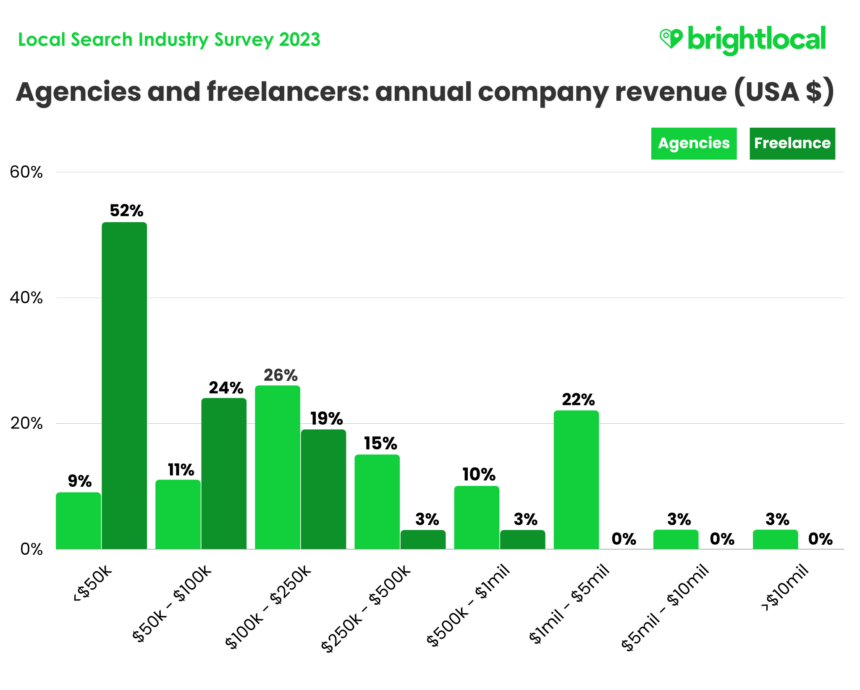
- More than half of freelancers see less than $50,000 in annual revenue.
- 22% of agencies earn between $1mil-$5mil in revenue.
We can see that revenue is fairly evenly distributed across the range for agencies, reflecting the various sizes and types that make up our agency participants. 71% are earning up to $1mil a year in revenue, 22% see between $1mil-$5mil revenue, and 6% earn over $5mil in revenue annually.
For freelancers, however, we can see this is very heavily weighted towards the ‘lower than $50,000’ bracket. 52% of freelance local marketing experts earn less than $50,000 in revenue.
While it should be noted that many of our freelance respondents told us that their consultancies run part-time alongside other employment, this finding still highlights the challenging environment for the self-employed—or those thinking about becoming self-employed.
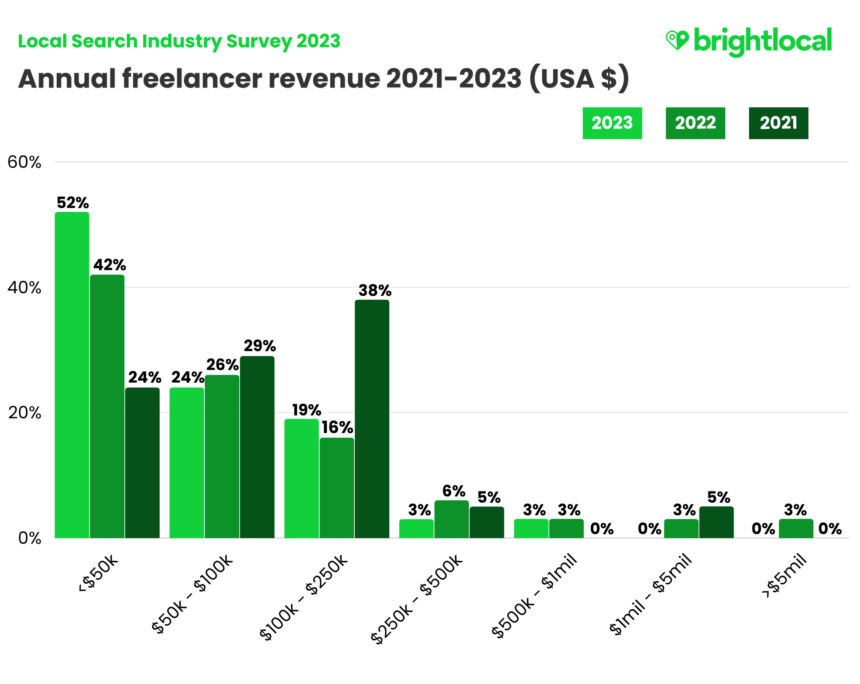
- The percentage of freelancers earning less than $50,000 in annual revenue has increased from 24% in 2021 to 42% in 2022 and 52% in 2023.
- 94% of freelancers are earning less than $250,000 in annual revenue in 2023.
When we isolate freelancer revenue and compare it to 2022 and 2021, it tells an even clearer story: we can easily see that freelancers are bringing in less revenue each year.
Annual revenue for single and multi-location businesses in the local marketing industry
Looking at annual revenue for single and multi-location businesses, we can see it is more weighted towards the higher end of the revenue brackets.
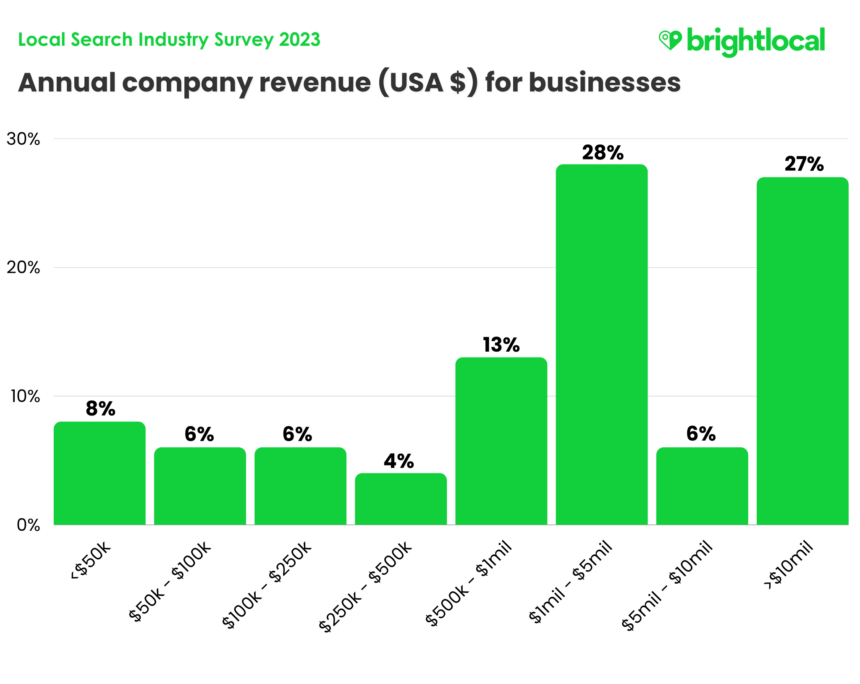
- 61% of single and multi-location businesses see over $1mil in annual revenue.
This information is useful for freelancers and agencies assessing their service pricing. Freelancers, particularly, may find they are pricing services too low—or perhaps billing in ways that end up disadvantaging themselves—so, it’s always good to see what businesses and brands are bringing in.
What are the most important local SEO metrics for success?
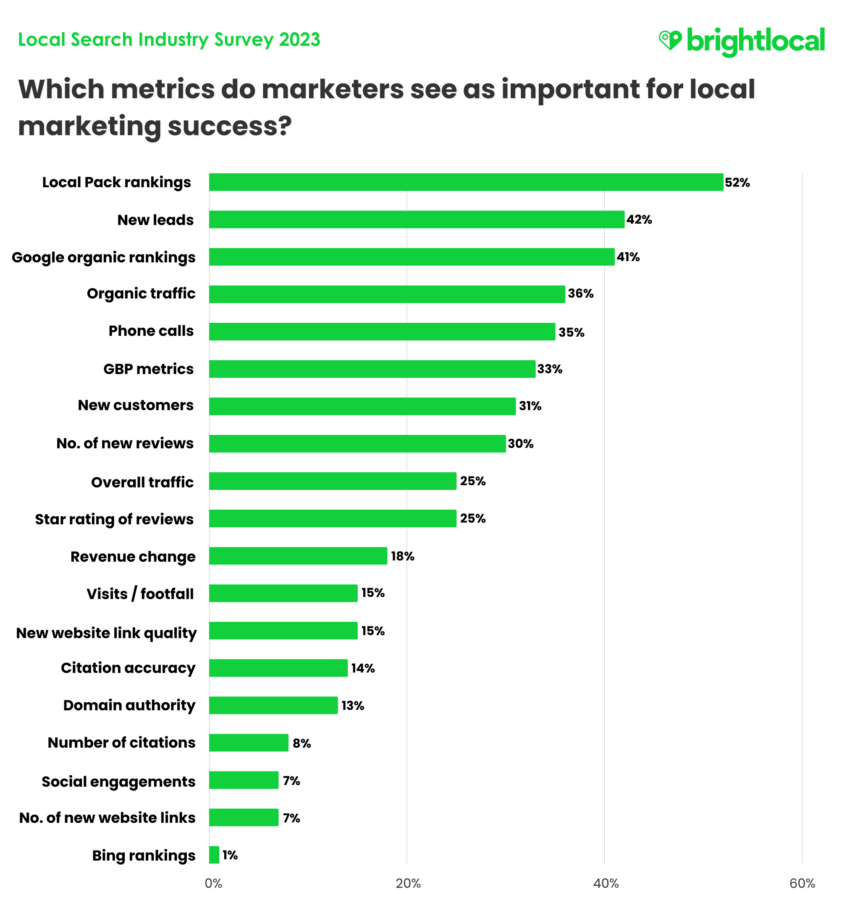
Everyone sees success slightly differently, which of course is why we have metrics in place to measure how we’re doing on the local front. But even key metrics tend to vary from business type to business type.
So, how do those marketing in-house measure local marketing success, compared to agency and freelance local SEOs?
| Metric | Agencies | Freelancers | Businesses |
|---|---|---|---|
| Rankings in the Google Local Pack / Local Finder | 54% | 50% | 44% |
| New leads/enquiries | 45% | 35% | 40% |
| Google organic rankings | 39% | 33% | 45% |
| Phone calls | 37% | 45% | 29% |
| Organic traffic | 37% | 33% | 33% |
| New customers | 33% | 33% | 27% |
| GBP metrics | 32% | 23% | 33% |
| Number of new reviews | 30% | 27% | 26% |
| Overall star rating of reviews | 24% | 27% | 25% |
| Overall traffic to website | 22% | 20% | 36% |
| Revenue change | 19% | 13% | 16% |
| Visits/footfall | 15% | 18% | 10% |
| Citation accuracy | 14% | 18% | 11% |
| Quality of new links | 14% | 25% | 12% |
| Domain authority | 12% | 12% | 20% |
| Number of new links | 8% | 5% | 8% |
| Number of citations | 7% | 5% | 7% |
| Social engagements | 5% | 8% | 15% |
| Bing rankings | 1% | 0 | 1% |
- 45% of businesses highlight Google organic rankings as important for local marketing success.
- 44% of businesses highlight Local Pack rankings as important for local marketing success.
- Google Local Pack rankings is the most important metric for both agencies (54%) and freelancers (50%).
- The top three local SEO metrics for agencies are Local Pack rankings (54%), new leads (45%), and Google organic rankings (39%).
- The top three local SEO metrics for freelancers are Local Pack rankings (50%), phone calls (45%), and new leads (35%).
We can see that businesses across the board are in agreement that Local Pack or Local Finder rankings in Google are one of the most important local SEO metrics. This makes sense, given the hierarchy and visibility these results tend to have within the SERPs. If you’re not displaying in the Local Pack, potential customers are not going to have easy access to key information like your business name, description, address, and phone number.
It is interesting to see that a higher percentage of agency marketers place high importance on new leads (45%) compared to businesses (40%) and that businesses are the most concerned with their organic rankings overall (45%).
Of course, improving (or maintaining) organic rankings have long been a desired goal for businesses of all types in the SEO world. But, with agency marketers highlighting new leads and freelancers highlighting phone calls (45%) as important success metrics, perhaps this goes to show that they are more familiar with the fluctuating tendencies of organic ranking and are more concerned with contributing to their clients’ bottom lines, showing value in doing so.
Generally, SEOs with wider industry experience keep abreast of things like algorithm changes, industry news, and ranking fluctations on behalf of their business clients. So, it makes sense that agency and freelance marketers look outside of organic rankings to secure local SEO success—because we all know unpredictable it can be out there!
Reacting to Changes in Local SEO
Each year, we ask local marketers a variety of questions around core elements of local SEO, namely whether reacting to algorithm updates continues to be a priority for them and their clients, as well as their thoughts on how, or if, key products like Google Business Profile (GBP) have improved.
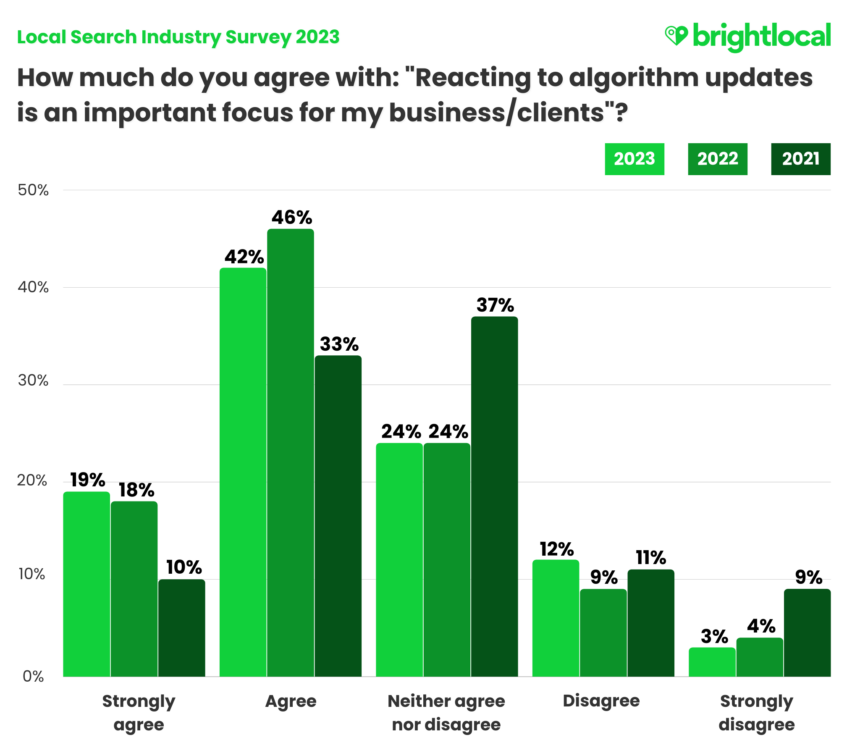
- 61% of marketers agree that reacting to algorithm changes is an important priority, down from 64% in 2022.
The numbers haven’t changed drastically year on year, but we can see a slight shift in how marketers are perceiving the importance of algorithm changes.
Google can take many months to confirm algorithm changes and, with so many unconfirmed updates throughout the year so far, you can’t blame SEOs for perhaps prioritizing them less than before, perhaps ‘waiting and seeing’ rather than reaction right away.
While fluctuating or disappearing rankings can be confusing and frustrating, it’s fair to say marketers are much savvier to the various different ways local SEO success can be achieved.
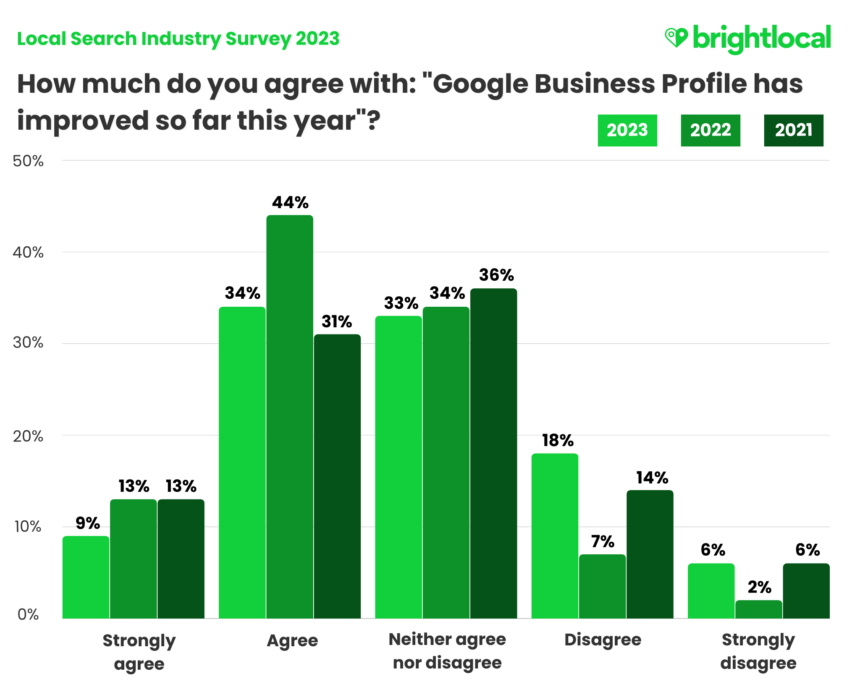
- 43% of marketers think GBP has improved in 2023, compared to 57% in 2022.
- 24% of local SEOs feel GBP has not improved in 2023, compared to just 9% in 2022.
It feels like Google Business Profile has changed a lot already in 2023, but it’s interesting to see that local marketers just aren’t loving it this year.
It’s worth noting that 2022’s survey was conducted and published before changes such as the NMX came in, bringing that flurry of bugs and annoyances along with it towards the end of the year. So, while a lot of significant changes have been made to GBP through 2023, it’s quite likely that some marketers are still pretty put out by those events.
Still, the floor is open. We recently reported on some positive new updates to GBP in July, so perhaps attitudes will change. Or could it be a sign that change is on the horizon? Perhaps local marketers are simply spreading their efforts across more local SEO tools and tactics.
A Day in the Life: Agency and Freelance Marketers
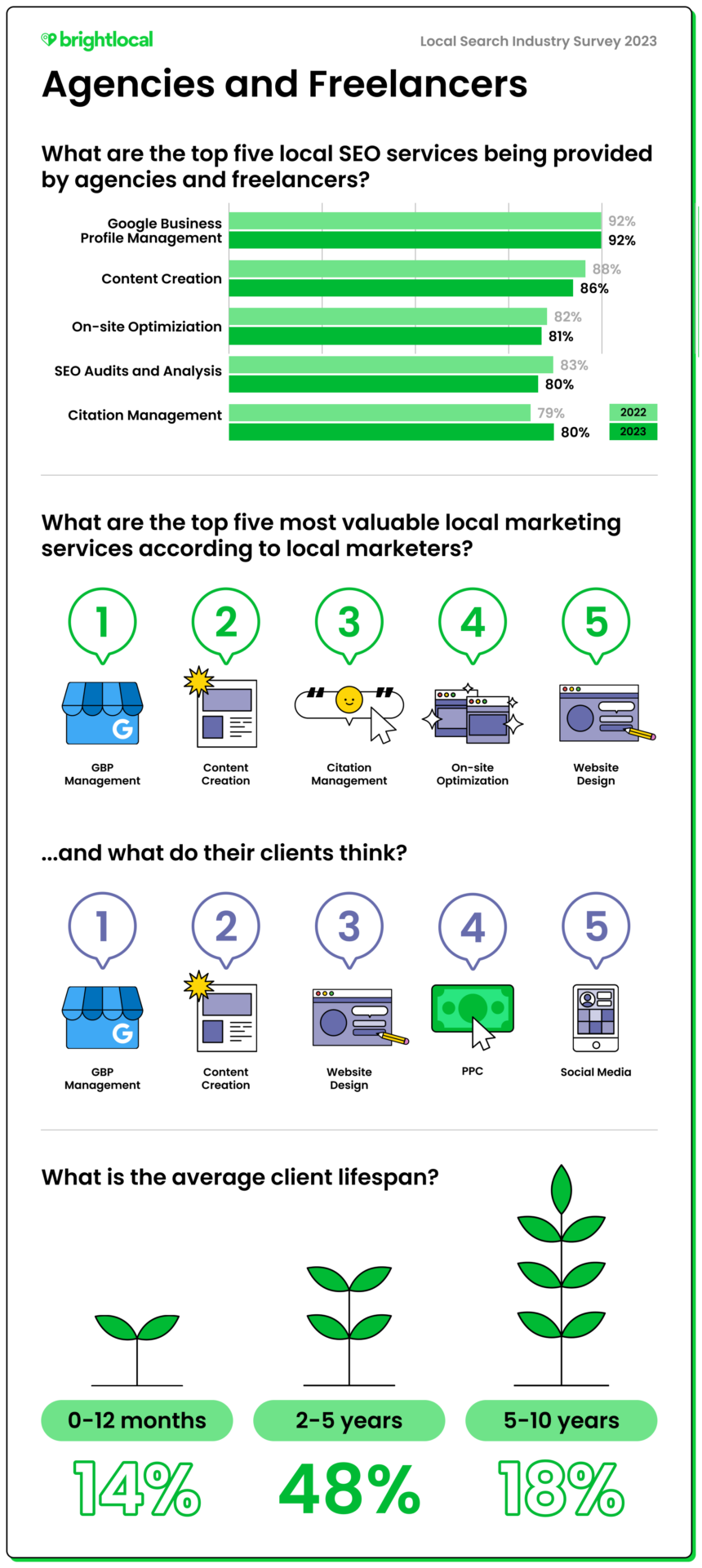
It’s always interesting to gauge how many clients local marketers have. In 2022’s report, local marketing agencies averaged 19 clients, while national marketing agencies averaged 16, and freelancers averaged 14.
How many clients do local marketers have?
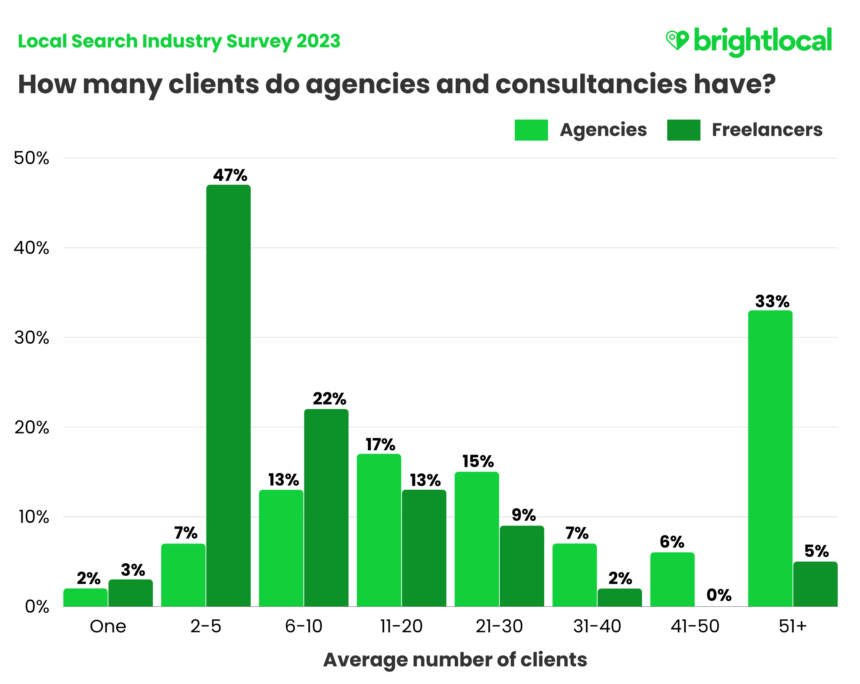
- 69% of freelancers have between two and ten clients.
- 33% of agencies have over 51 clients!
The sweet spot for freelancers appears to be having between two and ten clients (69%), but we were pretty shocked to see that a third of all agencies said they had over 51 clients! Even for some of the larger organizations, this seems like a lot.
Did you take part in this year’s Local Search Industry Survey? We’d love to find out more if you’re one of the marketers working with over 50 clients. Or, if you’ve got any theories as to why this number may be so high, do feel free to drop a comment in The Local Pack or reach out to us at [email protected]
Of course, all clients are different. You may have a variety of clients on retainer while working on one-off projects at the same time, and clients may come to you for very different services. Yet, seeing the polarizing results for freelancers and agencies here, it feels like a similar pattern to what we saw in annual revenue; freelancers way down at the lower end and agencies at the opposite side of the scale.
While freelancers don’t have the luxury of multiple colleagues on hand compared with agencies, it does raise the question of whether freelancers might simply be offering their small sets of clients too much in terms of services or output. If this is the case, time could easily be eaten up by a small number of clients, making it a challenge to find time for new client acquisition.
Average Client Lifespan
It’s interesting to consider the average lifecycle of a client partnership: if you have five clients that you’ve worked with for several years, that could be a highly valuable relationship. But if your two to five clients are turning over every six months or so, you may find yourself scrambling to pull together pitches for new business.
| Client Lifespan | Agencies | Freelancers |
|---|---|---|
| 0 - 6 months | 4% | 11% |
| 6 - 12 months | 8% | 14% |
| 1 - 2 years | 14% | 22% |
| 2 - 3 years | 23% | 19% |
| 3 - 5 years | 29% | 13% |
| 5 - 10 years | 18% | 17% |
| 10+ years | 5% | 5% |
- 25% of freelancers have clients with an average lifespan of 12 months or less, compared to 12% of agencies.
- 23% of agencies and 22% of freelancers have been working with clients for five years or more.
On the whole, it looks like agencies and freelancers are doing well at maintaining some lengthy client relationships. 96% of agencies work with clients for at least a month, although this is lower for freelancers at 75%.
It got us thinking, though: does a turnover of clients affect revenue? Would working in shorter cycles be more costly to the marketer overall, or would long-term partnerships end up benefitting a client more? What would be the ‘sweet spot’?
We took US revenue ($) and calculated the average for each client lifespan bracket.
| Client Lifespan | Avg Monthly Revenue per Client |
|---|---|
| 0 - 12 months | $799 |
| 1 - 2 years | $1,349 |
| 2 - 3 years | $1,569 |
| 3 - 5 years | $1,355 |
| 5 - 10 years | $1,190 |
| 10+ years | $1,285 |
There’s clear evidence to show that local marketers should be aiming for anything over 12 months for a more fruitful partnership. Meanwhile, the Goldilocks duration appears to be between two and three years. But don’t take that as a sign for binning off any of your long-standing clients! You obviously know what works for you, but it’s a really useful indicator to bear in mind.
What local SEO services do agencies and freelancers offer?
Seeing what local marketing services are—or aren’t—widely available is a great way to understand opportunities to expand the services you offer.
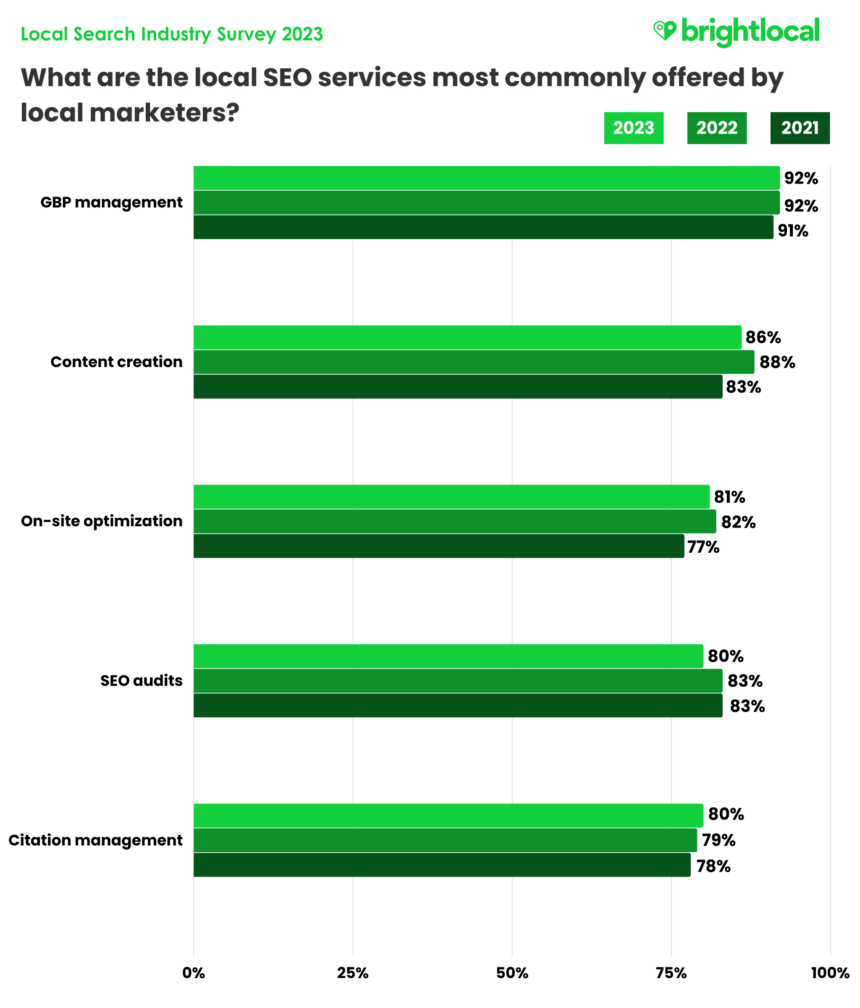
The graph above highlights the top five most commonly offered SEO services, and charts the changes year-on-year since 2021. These areas have largely held steady across the years, highlighting how they remain fundamental local SEO services.
As for a full run-down of services, let’s take a look at who’s offering what to their clients:
| Local marketing services offered | By agencies | By freelancers/consultants |
|---|---|---|
| GBP management | 92% | 91% |
| SEO audits | 81% | 75% |
| On-site optimization | 83% | 69% |
| Reporting/analytics | 72% | 56% |
| Citation management | 83% | 73% |
| Website design | 75% | 64% |
| Content creation | 86% | 86% |
| Competitor research | 73% | 70% |
| Google posts | 58% | 48% |
| PPC | 64% | 33% |
| Schema markup | 63% | 50% |
| Online review management | 58% | 45% |
| Social media | 55% | 42% |
| Outreach/link building/digital PR | 50% | 39% |
| Google Local Services Ads management | 50% | 34% |
| Email marketing | 48% | 34% |
| Video marketing | 26% | 17% |
| GBP spam fighting | 38% | 23% |
| Google penalty recovery | 22% | 27% |
| Influencer marketing | 10% | 5% |
| Technical SEO | 76% | 53% |
It’s no surprise to see that all of the ‘core’ local SEO services such as GBP management, content creation, auditing, analytics, and citation management are high up there for both agencies and freelancers. Although, there are some notable discrepancies:
- 72% of agencies offer reporting and analytics, compared to 56% of freelancers.
- 76% of agencies offer technical SEO, compared to 53% of freelancers.
- 64% of agencies offer PPC, compared to 33% of freelancers.
As agencies tend to have a variety of different experts in a team, it makes sense that they can offer such a breadth of local SEO services. However, as we discussed earlier, around the value of becoming a subject-matter expert, the lower figures for services provided by freelancers highlight some niche areas that could be very lucrative for clients. As we’ll come to below, clients do place value in some of the more niche marketing specialisms.
As well as technical specialisms like analytics, PPC, and technical SEO, there is a huge gap in the percentage of freelancers offering video (17%) or influencer marketing (5%).
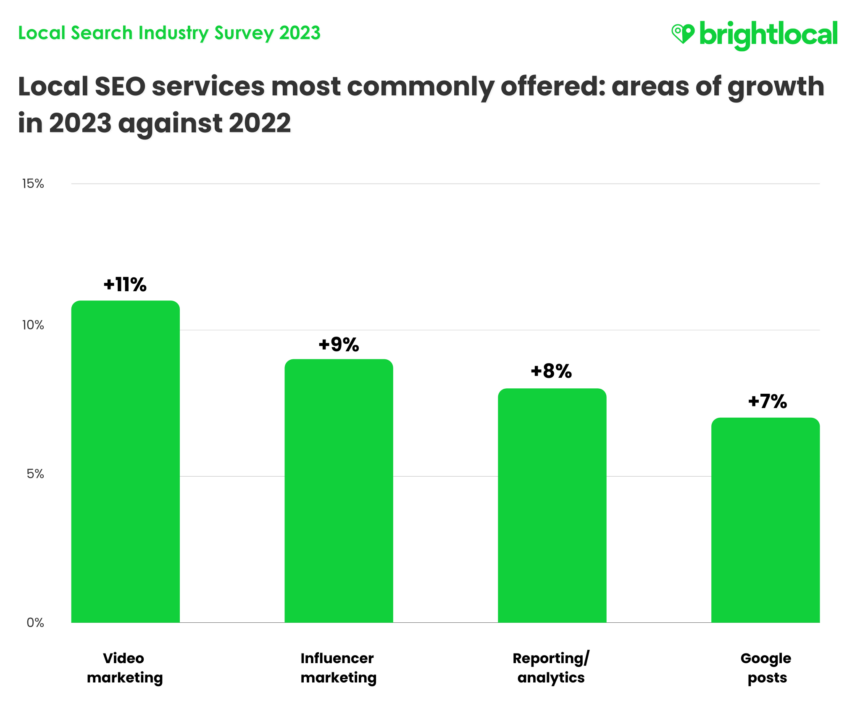
Despite being low down among the services offered, we can also see, however, the growth for video marketing and influencer marketing since 2022. With the introduction of video content to GBP profiles and Google Perspectives now rolling out and incorporating user generated content (UGC), it seems some local marketers have already switched onto the opportunities to offer services in these areas.
Moreover, the Local Consumer Review Survey 2023 found that 20% of US adults are using TikTok for new business discovery. Whether inciting influencers to create video content or encouraging local businesses to get on the platform themselves, it’s a lucrative area for local marketers to get involved in.
What local SEO services are considered the most valuable?
You know how it is. You’re proposing a strategy based around several key tactics, and a client chimes in with something like “oh, but I saw this thing on TikTok and…”
It’s always interesting to see which services marketers feel are the most valuable for their clients. However, this year, we also asked them what they think their clients believe are the most valuable.
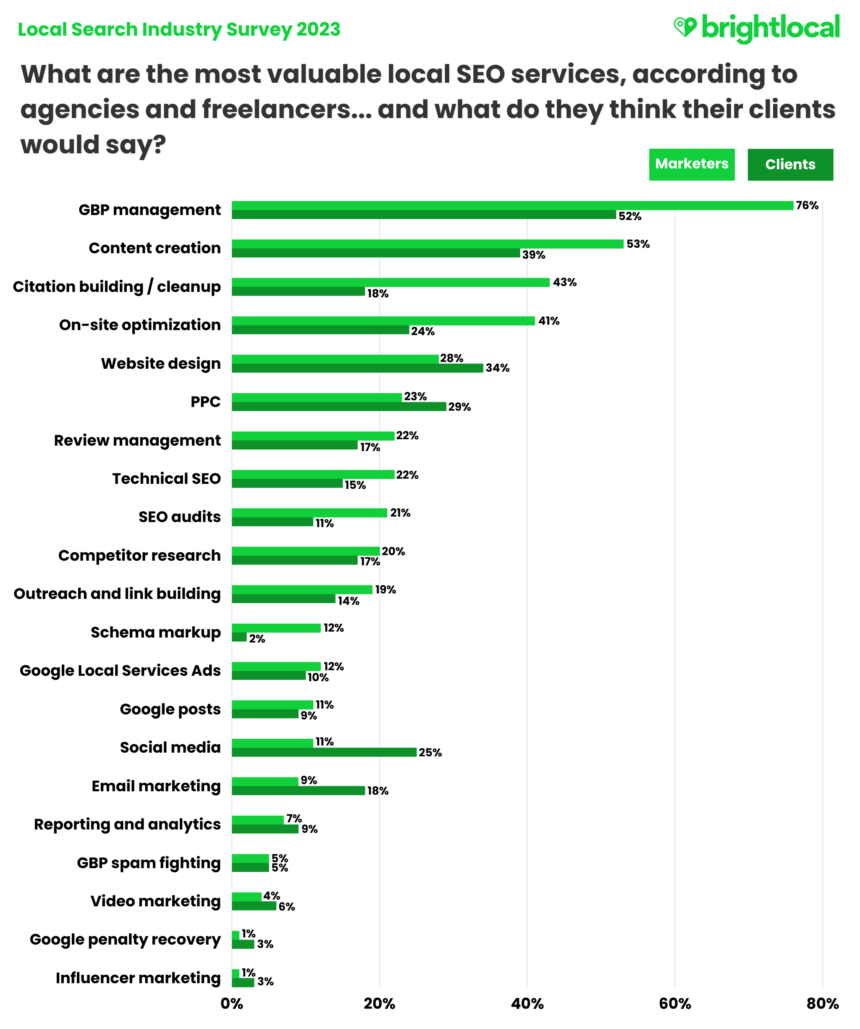
- The top three local SEO services that marketers see as most valuable are: GBP management (76%), content creation (53%), and citation management (43%).
- The top three local SEO services that clients see as most valuable are: GBP management (52%), content creation (39%) and website design (34%).
- 29% of clients see PPC as one of the most valuable local SEO services, compared to 23% of local marketers.
It’s encouraging to see that clients are fairly aligned with marketers in terms of priorities, which hopefully makes collaborating on strategy or getting buy-in from other stakeholders a little easier. However, it’s clear with services like website design, PPC, and social media that clients place importance in services that involve very immediate or visual changes.
It makes sense, in many ways: clients like seeing where their money is spent—or, even better, where the return on investment is coming from—but it can make pushing the case for more technical and behind-the-scenes elements like technical SEO a challenge.
You’ll note that citation management is not seen as a priority for clients, with less than a fifth of agencies and freelancers saying that their clients (18%) would highlight it as one of the most important services. As you may already be aware, citation management can be a tricky service to explain, and clients may not always understand the full scope of it as a service.
How are agencies and freelancers billing their clients?
It’s always useful to see what other people are doing, particularly if you are a freelancer or starting out as one. How should you bill your clients? There are a variety of methods by which agencies and freelancers prefer to bill, so we summarised the findings:
| Billing Method | Agencies | Freelancers |
|---|---|---|
| Monthly fee based on deliverables | 63% | 51% |
| Per project | 36% | 44% |
| Hourly rate | 28% | 43% |
| Monthly fee based on hours | 24% | 9% |
| Per lead | 2% | 3% |
| Day rate | 4% | 3% |
| Other | 8% | 3% |
It’s interesting to see that very few marketers are working on day rates, whether freelance or agency-based. It appears the general way to go is charging clients a monthly fee based on the deliverables they receive, with 61% of agencies and 53% of freelancers opting for this method.
However, 43% of freelancers are still billing at an hourly rate. Of course, it always comes down to preference, but hours can be a tricky figure to quote for some local SEO services—particularly in more creative areas such as copywriting and content creation or social media management, where tasks can end up taking a lot longer than you’d planned (or hoped).
Local Marketer Learning and Development
This year, we wanted to introduce the theme of learning and development, to find out not only where local marketers are seeking expertise, but whether they’re afforded the benefit of professional development as part of their employment.
As we know from the findings above, the more knowledgeable employees are the most satisfied with their salaries, so it should make sense that businesses want their employees to continue developing. But, how many local marketers have the opportunity?
Do local marketers have personal training budgets?
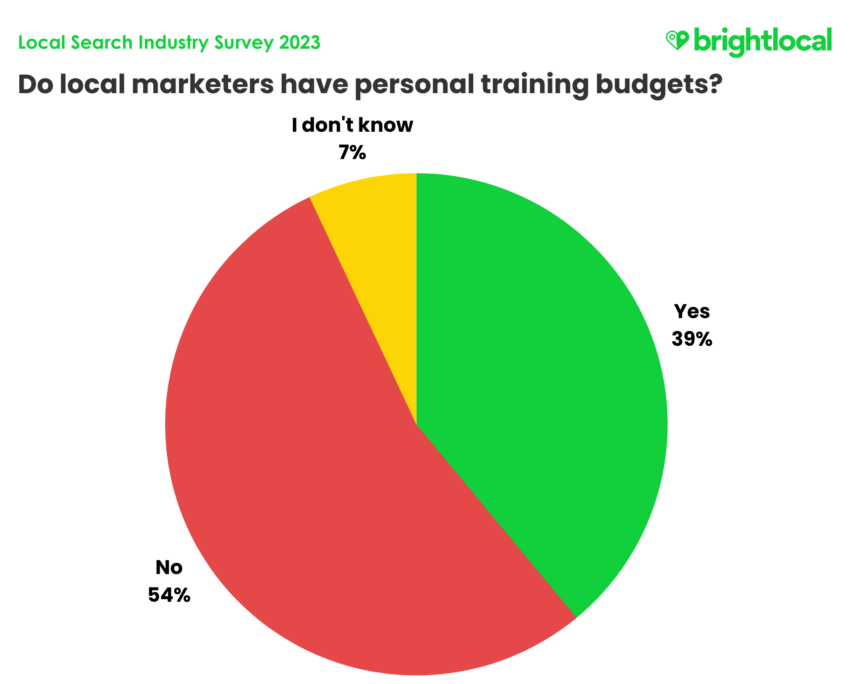
- Just 39% of local marketers are certain they have a personal training budget in their role.
- More than half of local marketers do not have a personal training budget.
It’s quite a sorry picture, with 54% of marketers not given a personal training allowance. Meanwhile, 7% of marketers were unsure, which suggests their organizations either do not offer the benefit or do not communicate them well enough. It’s a familiar sight to see vague mentions of ‘professional development’ and training within job specifications, but it’s very different for businesses to actively encourage their people to learn.
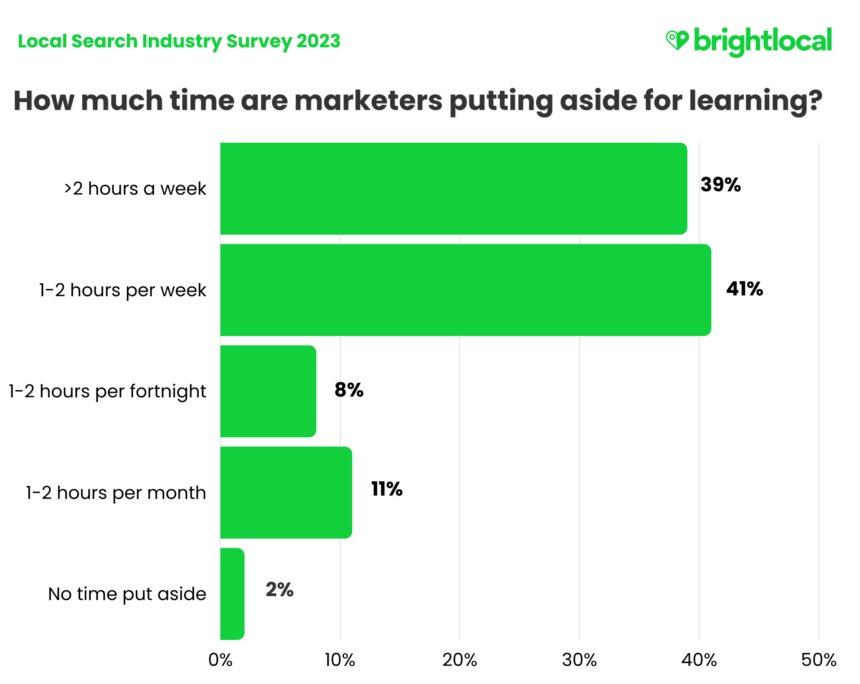
Despite this finding, local marketers are undeterred. A whopping 98% of marketers are putting time aside to learn within their roles, budget or none, with nearly two-fifths of those spending two hours or more learning. We love to see it!
Where are local marketers seeking expertise?
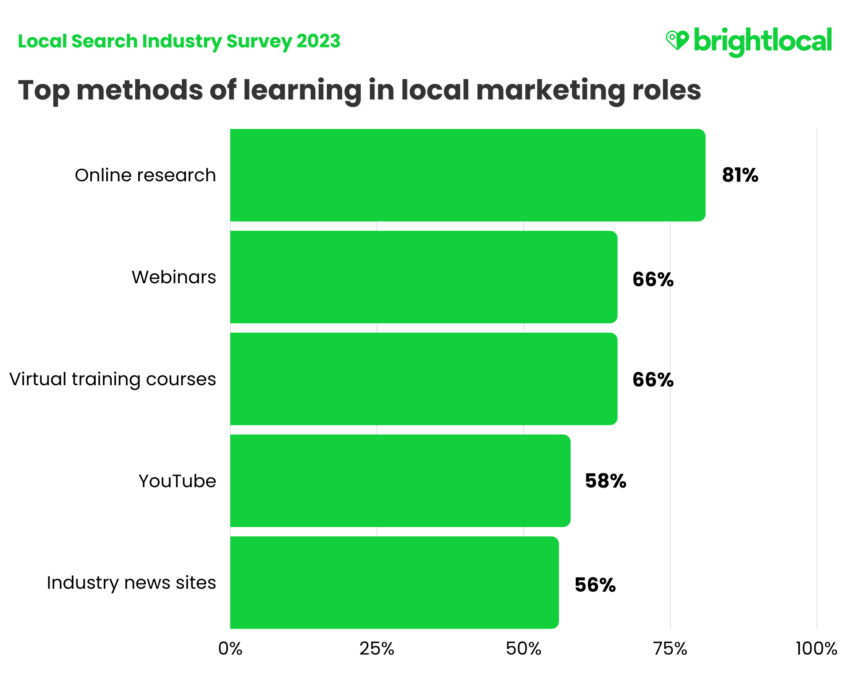
- 81% of local marketers are spending time researching to build their local SEO knowledge.
- 66% of marketers learn via webinars.
Unsurprisingly, the top methods of learning on the job (considering so few marketers have access to dedicated budgets) rely on the do-it-yourself approach. Research, webinars, YouTube, and industry news are generally all free—albeit timely—methods of learning, and it’s very encouraging to see there is a strong level of commitment in the industry.
This feels like a really good time to mention BrightLocal Academy…
Did you know that we offer free local SEO training courses via BrightLocal Academy? Our courses are delivered by renowned local marketers, with short, engaging lessons and activities that really help make the knowledge stick.
Enrol for free and discover interactive video courses on:
Looking to the Future: New Tech, Optimism, and Hiring Trends
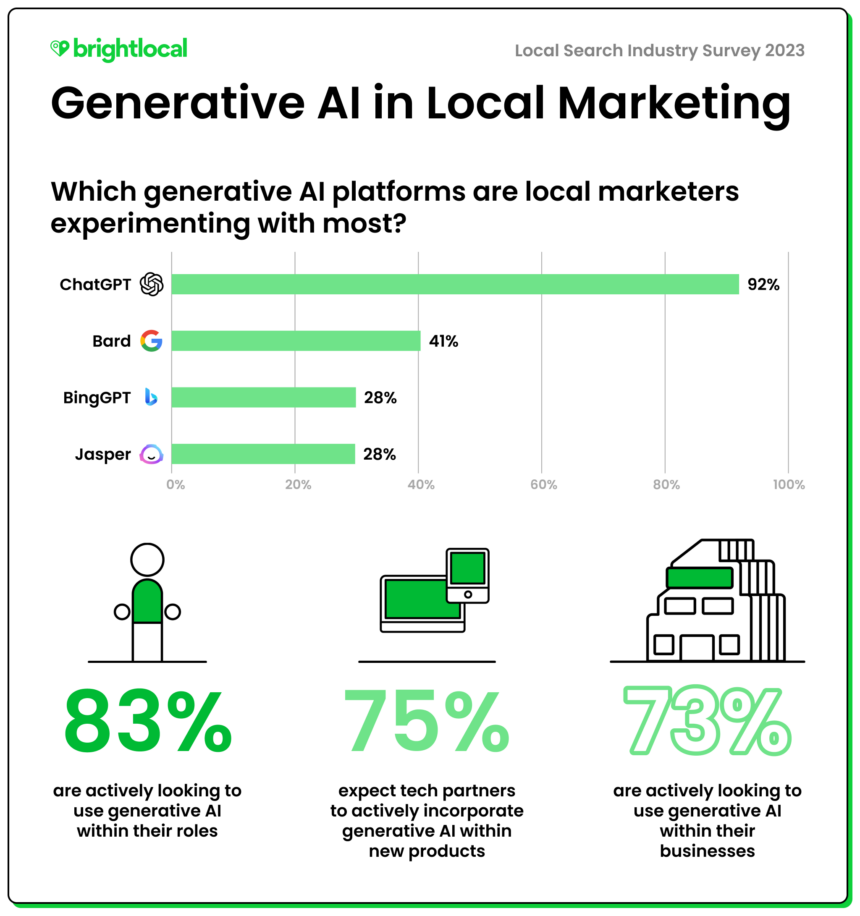
We’ve got a clear picture of how marketers are doing in local SEO right now, but what about next year—and beyond? With much of 2023 already dominated by discussion around developments in generative AI, competitor brands, and changes to SERPs, how do marketers feel about achieving local success in 2023?
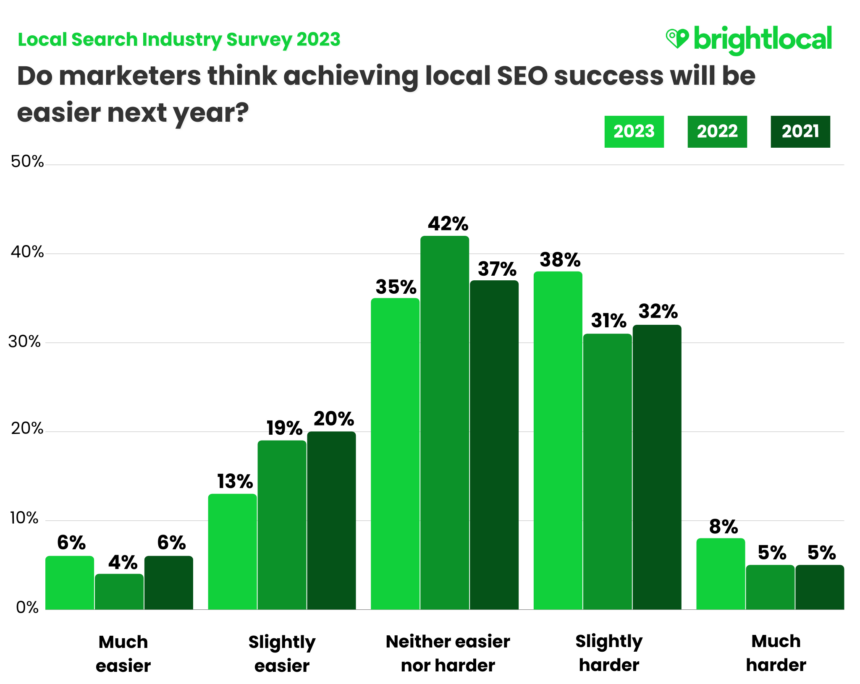
There has been a decrease in the percentage of marketers feeling optimistic about achieving local SEO success in the next year, from 23% in 2022 to 19% in 2023.
Alongside this, we can see a corresponding increase in the percentage of marketers feeling pessimistic about their chances of local marketing success, from 36% in 2022 to 46% in 2023.
As well as the aforementioned developments in generative AI that have hit marketers thick and fast so far this year, there have been other significant changes within the industry that could contribute to feelings of apprehension about 2024.
Despite this fast-growing innovation, the start of 2023 saw plenty of turbulence with lay-offs affecting some of the world’s biggest tech companies. Not to mention the chaos at Twitter, now X, which impacted businesses of all sizes as marketers grappled with the potential loss—and still ever-changing nature—of this important marketing channel.
Moreover, with Google’s new generative AI-led search functionality, Search Generative Experience (SGE), likely coming at some point in 2024, this adds another key component to marketers’ growing lists of things to master.
Will marketers be hiring in the near future?
With a sense of apprehension around achieving success in the industry, how does this leave marketers feeling about growing their businesses with new hires?
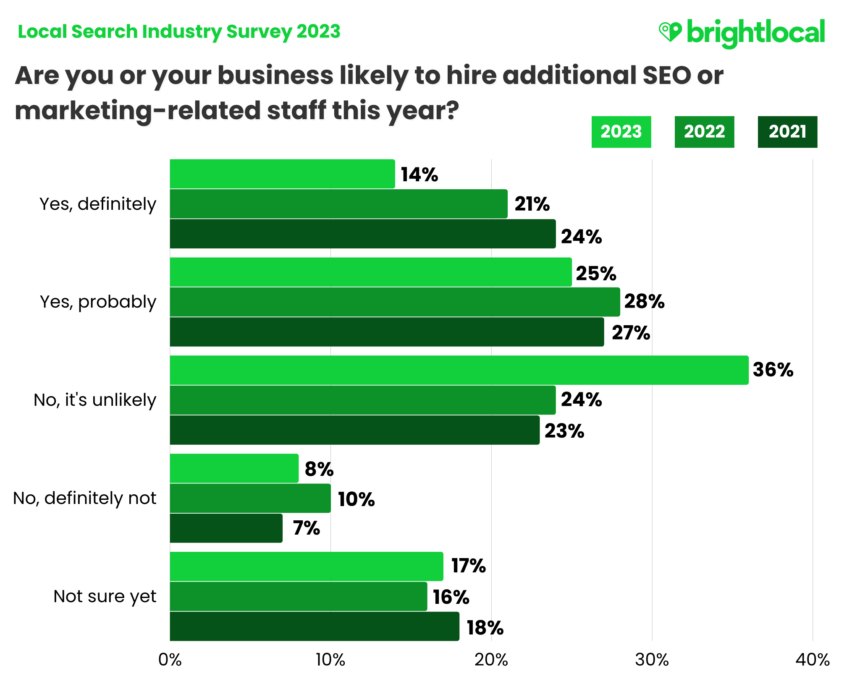
- 44% of marketers will not be hiring this year, compared to 36% in 2022 and 30% in 2021.
The chart shows a clear trend in business hiring activities, with decreases in the percentage of marketers looking to hire since 2021. The most significant drop comes under the ‘definite’ statement, from 21% in 2022 to just 14% in 2023.
Although there is evidence to suggest that inflation is easing in the US, the cost of hiring and retaining employees is often the biggest outgoing for businesses, so it’s a decision that can’t be taken lightly.
Generative AI in Local Marketing
Meanwhile, local marketers are feeling hopeful about developments in generative AI and what it could mean for business.
A recap on generative AI
While artificial intelligence has been around for some time (and probably much longer than you think!), 2023 exploded with generative AI talk.
Generative AI models use various forms of machine learning to generate content, like text and images.
We covered some early use cases, pros and cons of generative AI in local marketing back in January. More recently, we collated the thoughts of digital marketing and local SEO experts in an Expert Focus.
While our recent generative AI case study highlighted that 73% of US adults have not used generative AI tools, it’s a very different story within the local SEO niche. Just 7% of marketers have not used generative AI to experiment within their roles. Of the 93% that have, these are the tools they’ve used:
| Generative AI Tools | Marketers Experimenting |
|---|---|
| ChatGPT | 92% |
| Bard | 41% |
| BingGPT | 28% |
| Jasper | 28% |
| Copy.ai | 22% |
| DALL·E | 22% |
| Midjourney | 20% |
| Content at Scale | 6% |
| Craiyon | 2% |
And it seems, for the most part, local marketers are impressed by what they’ve seen so far. We presented several statements around the use of generative AI within local marketing, whether for their roles or wider businesses as a whole.
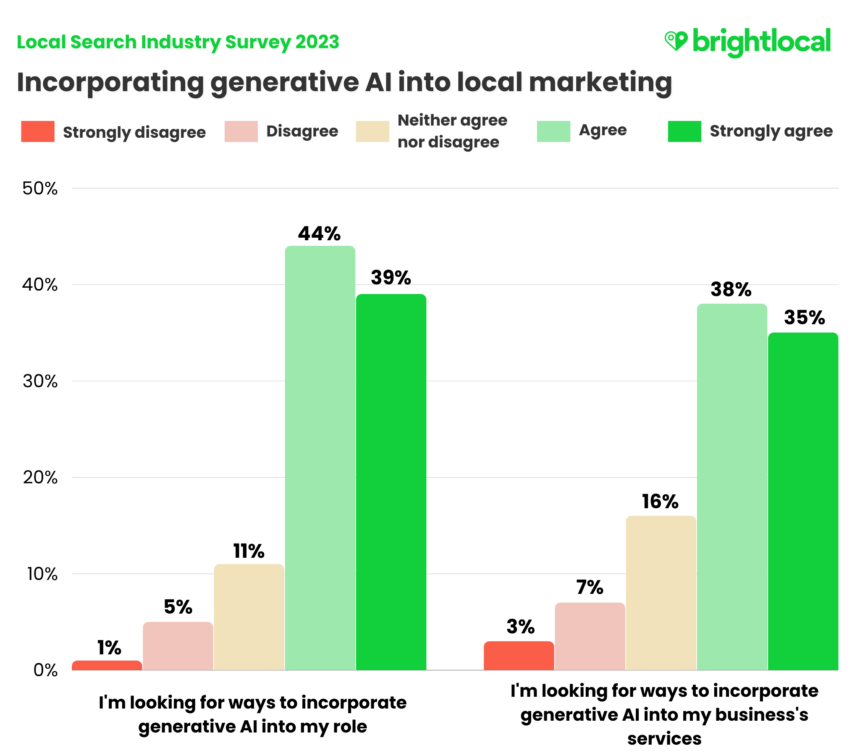
- 83% of marketers are actively looking to incorporate generative AI into their roles.
- 73% of marketers are actively looking to incorporate generative AI into their business.
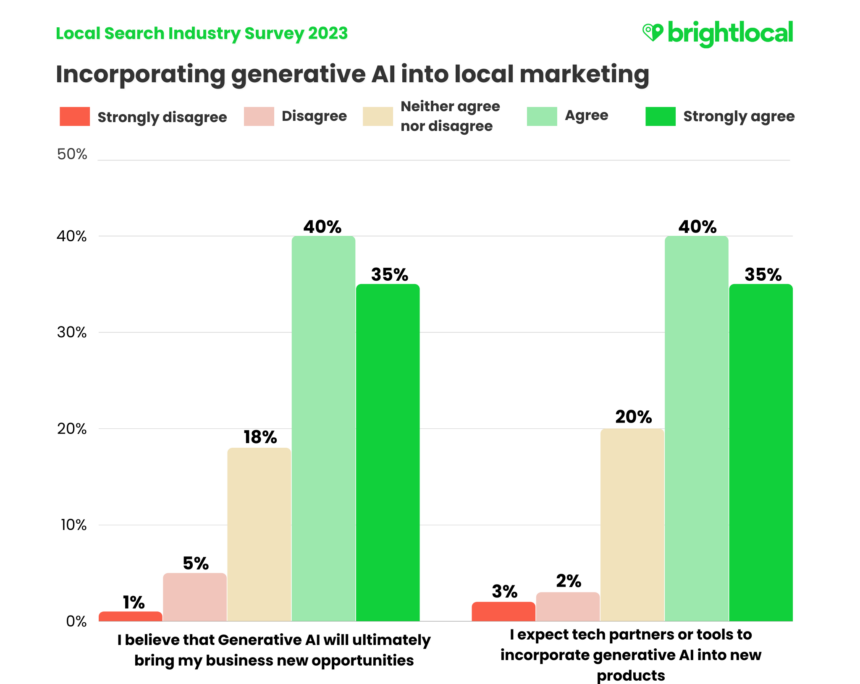
- 75% of local marketers feel that generative AI will bring new business opportunities.
- 75% of marketers expect potential tech partners or new tools to be actively incorporating generative AI into products.
So, while we’re not saying you absolutely should be jumping on the bandwagon, it’s good to keep in mind what your peers and competitors are doing with generative AI. With 75% of marketers agreeing that generative AI will bring new opportunities, it might be worth carving out some time to discover what these might be for yourself.
Moreover, for digital marketing or web design agencies and marketing software organizations, the finding that 75% of local marketers expect tech partners and tools to be actively incorporating generative AI into their products definitely cannot be overlooked!
Share your thoughts with us
Thanks for reading this year’s Local Search Industry Survey report, and we’d like to say an enormous thank you again to the local marketers who participated in the survey!
We hope you found these benchmarks useful. Does the information ring true for your experience in local search, or do you have any differing experiences you’d like to share? Please consider joining the conversation with our community of over 2,000 local SEOs over on The Local Pack, drop us a tweet, or mention us on LinkedIn.
About the Local Search Industry Survey 2023
Local marketing audience data
The Local Search Industry Survey was conducted via SurveyMonkey and received a total of 534 responses through our subscriber channels, customer base, social media, and peers within the community.
Although SurveyMonkey only asks participants for binary gender information and therefore doesn’t provide a wholly accurate representation of our audience, 37% of respondents identified as female, 60% identified as male, and the remaining 12% preferred not to disclose their gender.
We surveyed local SEO and marketing representatives from the following business types:
| SEO Agency | Freelancer | Single-location Business | Multi-location Business | Web Design agency | Marketing Software | Other |
|---|---|---|---|---|---|---|
| 53% | 13% | 10% | 11% | 10% | 2% | 1% |
72% of this year’s respondents identified as local marketers based in the US. The remaining 28% represent the UK (6%), Canada (5%), Australia (3%), and 24 other countries (14%).
Publishers are welcome to use the charts and data outlined within this report, crediting BrightLocal and linking to this article’s URL. If you have any questions about the report, please contact [email protected] or [email protected].
